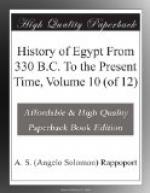From the very earliest times, says Ebers, the Pharaohs had understood the necessity of measuring exactly the amount or deficiency of the inundations of the Nile, and Nilometers are preserved which were erected high up the river in Nubia by kings of the Old Empire, by princes, that is to say, who reigned before the invasion of the Hyksos. Herodotus tells us that the river must rise sixteen ells for the inundation to be considered a favourable one. If it remained below this mark, the higher fields failed in obtaining a due supply of water, and a dearth was the result. If it greatly exceeded it, it broke down the dykes, damaged the villages, and had not retired into its bed by the time for sowing the seed. Thus the peasant, who could expect no rain, and was threatened neither by frosts nor storms, could have his prospects of a good or bad harvest read off by the priests with perfect certainty by the scale of the Nilometer, and not by the servants of the divinities only, but by the officers of the realm, who calculated the amount of taxes to be paid to them in proportion to the rising of the river.
[Illustration: 254.jpg NILOMETER AT RHODHA]
The standard was protected by the magic power of unapproachable sanctity, and the husbandman has been strictly interdicted from the earliest time to this very day from casting a glance at it during the time when the river is rising; for what sovereign could bear to disclose without reserve the decrees of Providence as to the most important of his rights, that of estimating the amount of taxes to be imposed? In the time of the Pharaohs it was the priesthood that declared to the king and to the people their estimate of the inundations, and at the present day, the sheik, who is sworn to secrecy, is under the control of the police of Cairo, and has his own Nilometer, the zero point of which is said to be somewhat below that of the ancient standard. The engineers of the French expedition first detected the fraud, by means of which the government endeavoured every year to secure the full amount of taxes.
When the Nile has reached a height of a little over fifteen old Arabic ells, it exceeds its lowest level by more than eight ells, and has reached the height requisite to enable it to irrigate the highest fields. This happy event is announced to the people, who await it with breathless anxiety, and the opening of the dykes may be proceeded with. A festival to celebrate this occasion has been held from the remotest times. At the present time customs prevail which can, it is alleged, be traced by direct descent to the times of the Pharaohs, and yet during the dominion of Christianity in Egypt, and later again under sovereigns governing a nation wholly converted to Islam, the old worship of the Nile, with all its splendour, its display, and its strange ceremonies, was extirpated with the utmost rigour. But some portion of every discarded religion becomes merged in the new one that has supplanted




